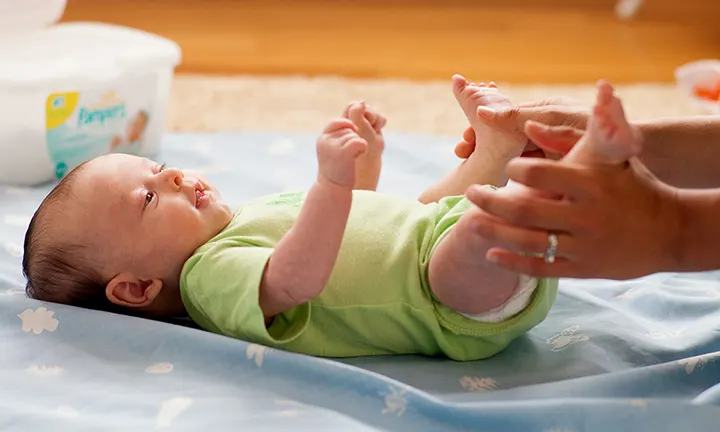Pamper’s Baby Diaper Size Chart Guide
Choosing the right diaper size for your baby can feel overwhelming, but we're here to help. Pampers has collaborated with thousands of families, taking over a half-million diaper-fit measurements to create a reliable range of diaper sizes by weight. With this guide, you'll have an easy reference to find the perfect fit as your baby grows, ensuring comfort and leak protection at every stage.
Pampers Baby Diaper Size Chart Guide
Understanding how diaper sizes work may help simplify the decision-making process. While many parents wonder about diaper size by age, age isn’t the best indicator. After analyzing hundreds of thousands of diaper-fit measurements, Pampers has determined that diaper sizes by weight are the most reliable factors to consider when selecting the right size.
As you explore the diaper size chart below, remember that your baby’s weight plays the most crucial role in determining the best fit.
To make things easier, we’ve also addressed two common questions:
Should you buy a specific number of diapers in each size? Babies grow at their own pace, so it’s often best to wait and see before stocking up on a particular size. For general planning, we’ve included the average number of diapers a baby usually uses in each size on our chart.
How long will my baby wear each size? While every baby is different, we’ve included the average number of months a baby usually wears each size. For example, many newborns wear newborn diaper sizes for about a month and a half.
Pampers Baby Diaper Size Chart by Weight
This Pampers diaper size chart provides you with a quick guide to finding the right size for your baby based on their weight, ensuring the best fit and comfort. Here's how you can determine which size works best as your baby grows:
*Can vary by baby, age, and individual habits and practice How to Use the Chart:
Weight ranges. The chart is primarily based on diaper sizes by weight to ensure a snug and comfortable fit for your baby. You can determine your baby’s weight at home or during a well-baby visit. For example, a size 1 diaper's weight range is for a baby between 8 and 14 pounds, whereas a size 2 diaper’s weight range is between 12 and 18 pounds. Similarly, the size 4 diaper weight range is ideal for babies weighing 22 to 37 pounds, and size 5 diaper weight is typically for babies over 27 pounds.
Number of diapers per day. This is an average, and your baby’s needs might vary.
Duration in each size. This is an estimate of how long your baby will remain in each size before moving up to the next one. Babies grow at their own pace, so always monitor their fit.
Diaper types. The chart also lists the available Pampers diaper types in each size. Depending on your baby’s needs, whether it’s extra protection during the night or for swimming, you can choose the best option.
Some weight ranges overlap, so it’s helpful to monitor your baby’s fit to know when to switch sizes. Keep reading to learn more about finding the perfect fit, when to size up in diapers, and which Pampers diaper is best for your baby’s needs. Plus, pick-up tips on preventing leaks and blowouts ensure a more comfortable diapering experience.
Newborn Diapers
When caring for your newborn, choosing the right diaper is essential for keeping your baby comfortable and dry. Infant diaper sizes (Size N) are specifically designed for infants weighing up to 10 pounds. These diapers normally come with a special cutout for the umbilical cord, helping to prevent irritation while it heals during those first few weeks of life.
Newborns tend to go through a lot of diapers—often up to 10 per day—which means it's a good idea to have a healthy supply ready.
If your baby is born smaller, Pampers also offers three different preemie sizes, providing a snug and protective fit for even the tiniest of babies.
As your baby grows, it’s important to monitor their weight to help you decide when to transition from a newborn diaper size to the next. Many parents find that they need to switch to size 1 diapers within the first few months as their baby starts to gain weight.
For more guidance on umbilical cord care or if you’re wondering how many newborn diapers you’ll need you can read our articles to help you get started or prepare for your baby’s arrival.
When to Size Up Diapers
Beyond just an increase in weight, there are several signs that your baby might be ready for a larger diaper. Knowing when to size up in diapers can ensure your baby stays comfortable and avoids leaks. Here are a few key signs to help you know when to size up diapers:
If the fastening tapes don't reach the center of the waistband, it's likely time for a bigger size. Conversely, if the tapes overlap, the diaper may be too large.
If you can't comfortably fit two fingers under the waistband of the fastened diaper, it's time for a bigger size.
Red marks on your baby's tummy or thighs when removing the diaper indicate that the diaper may be too small.
If the diaper isn't fully covering your baby's bottom, choose a bigger size.
Frequent diaper rash, may be because the diaper is too small and doesn’t keep the moisture away from the skin.
If your baby shows signs of discomfort, such as pulling at the diaper, they might need a bigger size.
By paying attention to these indicators, you can ensure a better fit and greater comfort for your baby. For additional tips on how to know when to size up diapers, you can test your knowledge with the Pampers quiz below!
How Should a Diaper Fit?
Every baby is unique so a diaper fit can vary depending on your little one’s size and shape. Pampers diaper sizes are based on your baby’s weight, which is the most accurate way to determine the best fit—not age or gender. Most of the time, your baby’s weight will fall within a specific diaper size range, but sometimes, you may find yourself choosing between two sizes due to overlapping weight ranges.
For example, a size 4 diaper normally fits babies weighing 22 to 37 pounds, while a size 5 diaper is designed for those over 27 pounds, and size 6 diapers accommodate babies above 35 pounds.
With this overlap, here’s how to ensure the diaper fits properly:
Position the waistband: A well-fitting diaper should sit snugly just below your baby’s belly button.
Look at the leg cuffs: There should be no gaps around the leg cuffs. Running two fingers inside the cuffs after putting the diaper on can help prevent leaks.
Waist comfort: You should comfortably fit two fingers under the waistband of the fastened diaper. This ensures it’s neither too tight nor too loose.
Inspect for red marks: After removing the diaper, check for any red marks on your baby’s skin. These marks may indicate the diaper is too tight, and adjusting the size or fit might be necessary.
By focusing on how the diaper should fit properly, you’ll not only avoid discomfort but also help prevent leaks and blowouts. The right fit ensures your baby stays dry and happy throughout the day. If you’d like more guidance, try our My Perfect Fit tool to find the ideal fit for your little one.
Which Pampers Diaper Is Best for My Baby?
As your baby grows and reaches new development milestones, their diaper needs will change. Whether your little one is a newborn or an active toddler, Pampers offers a full lineup of diaper sizes and products to support every stage of their development.
Here are some things to consider when choosing which Pampers product to buy:
For Newborns
As newborns have very delicate skin, they require extra softness and protection. You can expect our newborn diapers to be:
very soft
super absorbent to keep your baby's skin dry
designed so it doesn't rub against the umbilical cord stump
easy to put on and fasten.
You’ll find newborn diaper sizes in Pampers Swaddlers, Pampers Pure Protection, and Pampers Baby-Dry.

For Growing Babies
As your baby becomes more mobile, choosing the correct fit is key to preventing leaks as you transition diaper sizes. For growing babies, choose a diaper that’s
super absorbent to keep your baby’s skin dry
designed to move with your baby
easy to put on and take off.
At this stage, consider Pampers Cruisers 360 and Pampers Swaddlers 360.

For On-the-Go Babies
When your little one is crawling, beginning to walk, or running easily, you’ll need something you can change quickly. So, with active babies, consider diapers or pants that are
easy to take off quickly
move with your baby as they play and crawl around
extra absorbent and keep your baby’s skin dry.
For example, you might like our Pampers Easy Ups, Pampers Swaddlers 360, and Pampers Cruisers 360.

For Overnight Protection and Swimming Convenience
Although all Pampers diapers and pants are designed with optimal absorption and leak protection, the following are best for swimming and overnight protection.
Pampers Swaddlers Overnights offer extra absorption, breathability, and softness for a comfortable snooze.
Pampers Splashers are highly absorbent without swelling, so the fit and feel don’t change when your little one is playing in the water.
This chart summarizes available sizes for each product (and includes swim diaper sizes, too) to help you select the right Pampers diapers or pants:
Why the Right Size Matters
When your little one wears the correct diaper size, good things happen! A properly fitting diaper not only keeps your baby dry but also helps prevent common issues like leaks and blowouts. When the diaper size aligns with your baby’s weight, the diaper performs as intended, ensuring comfort and minimizing skin irritation.
Here's what could happen if your little one isn’t wearing the correct diaper size:
If a diaper is too small, it can leak because there isn’t enough absorbency for the volume of baby poop or pee. The diaper can’t properly do its job, and moisture can irritate your baby’s skin.
If the leg cuffs don’t fit properly or are tucked inside the diaper, pee can leak out the sides.
If a diaper is too big, baby pee and poop may leak out of the gaps before the diaper can absorb it, which also leads to skin irritation.
Choosing the correct diaper size, helps your little one stay dry, comfortable, healthy, and clean.
The Bottom Line
Once you've found the perfect fit for your baby using the diaper size chart and learned how to change a diaper like a pro, selecting the right diaper size will be effortless. A properly fitting diaper keeps your baby more comfortable, while also reducing the chances of leaks and blowouts. Even with the best fit, accidents can happen, so be sure to stay prepared with our diaper bag checklist for all situations.
And don’t forget to treat yourself! By using the Pampers Club app, you can earn rewards for every diaper and baby wipe purchase, making all those diaper changes a little more rewarding.
How We Wrote This Article The information in this article is based on the expert advice found in trusted medical and government sources, such as the American Academy of Pediatrics and the American College of Obstetricians and Gynecologists. You can find a full list of sources used for this article below. The content on this page should not replace professional medical advice. Always consult medical professionals for full diagnosis and treatment.
Join a World of Support
through Pregnancy and Parenthood.
TRACK WITH TOOLS
LEARN WITH EXPERTS
GET REWARDED












